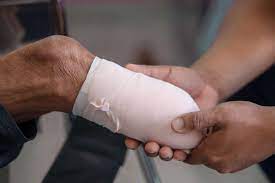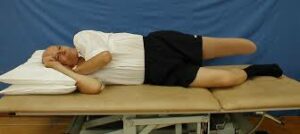A transtibial amputation is a surgery where the lower portion of the leg is removed. This type of amputation occurs when there is damage to the knee, ankle, or foot. Recovery after a transtibial amputation can be difficult, but with the proper care and rehabilitation, you can regain your mobility and independence. In this comprehensive guide, we will discuss everything you need to know about recovering after a transtibial amputation.
Contents
- 1 Understanding Transtibial Amputation
- 2 What Are The Types Of Transtibial Amputation?
- 3 What Are The Complications Of Transtibial Amputation?
- 4 How Can A Physical Therapist Help In This Condition?
- 5 How Long Does It Take To Recover From A Transtibial Amputation?
- 6 What Are Some Tips For Recovery?
- 7 Treatment options For transtibial amputation
- 8 Conclusion
Understanding Transtibial Amputation
The most common type of lower-limb amputation is a transtibial, or below-the-knee (BTK), amputation. In this procedure, the surgeon removes the foot and part of the lower leg, typically just above the ankle. The remaining limb is then fitted with a prosthesis or artificial limb.
Transtibial amputation is usually performed as a result of an injury, infection, or disease that has caused significant tissue damage or loss. In some cases, the procedure may be elected as a preventive measure to avoid future complications. For example, people with diabetes often undergo BTK amputations to prevent the spread of infection.
What Are The Types Of Transtibial Amputation?
The main types of transtibial amputation are:
Partial foot amputation: This is also called a toe or metatarsal amputation. It involves removing part of the foot, usually just the toes.
Lisfranc amputation: This type of amputation involves removing part of the midfoot. It’s named after Jacques Lisfranc de St. Martin, the French surgeon who first described the procedure in 1815.
Buckland amputation: This is also called a transmetatarsal amputation. It involves removing the metatarsals, or bones in the middle of the foot.
Chopart amputation: This type of amputation involves removing the talus and calcaneus, or ankle bones.
Pirogoff amputation: This is also called a Transcalcaneal or subtalar joint amputation. It involves removing the heel bone.
What Are The Complications Of Transtibial Amputation?
The most common complications of transtibial amputation are:
Infection
This is the most common complication of all types of amputation. Infection can occur at the site of the incision, in the bone, or in the soft tissue. It can also occur in the stump, where the amputated limb meets the body.
Phantom limb pain
This is a type of pain that occurs in the limbs that have been amputated. It’s caused by nerve endings that are still present in the amputated limb.
Stump pain
This is a type of pain that occurs in the stump of the amputated limb. It can be caused by infection, nerve damage, or the way the stump is healing.
Dry socket
This is a complication that can occur after an amputation. It happens when the blood clot that forms at the site of the amputation is dislodged. This can cause pain, swelling, and infection.
Skin problems
Amputation can cause a variety of skin problems, including ulcers, rashes, and infections.
Blood clots
Blood clots can occur in the veins of the amputated limb. They can also occur in the arteries, which can lead to a heart attack or stroke.
Lymphoedema
This is a condition that can occur after an amputation. It happens when the lymphatic system, which is responsible for draining fluid from the tissues, is damaged. This can cause swelling and pain.
How Can A Physical Therapist Help In This Condition?

A physical therapist (PT) can design a rehabilitation program that will stretch and strengthen the muscles around the residual limb. The PT can also teach patients how to use their new prostheses effectively.
In addition, the Physical therapist may:
- Encourage the patient to use any remaining muscle function to control the prosthesis.
- Teach the patient how to transfer safely from one surface to another, how to walk up and down stairs, and how to negotiate curbs and other obstacles.
- Help the patient regain confidence in performing daily activities.
Most people who have a transtibial amputation can go home within a week. Once home, you will continue to see your surgeon and prosthetist for follow-up care. It is important to keep all follow-up appointments so that your progress can be monitored.
How Long Does It Take To Recover From A Transtibial Amputation?
The short answer is that it takes as long as it takes. There is no set time frame for how long someone will need to recover from a transtibial amputation. Every individual is different and will heal at their own pace. Some people may be able to return to their previous level of activity relatively quickly, while others may need a more gradual return.
In general, the healing process can be divided into three phases:
1. The acute phase: This is the period immediately following surgery when the focus is on managing pain and protecting the surgical site while it heals.
2. The rehabilitation phase: Once the surgical site has healed, the focus shifts to regaining strength and mobility. This phase may last several months.
3. The maintenance phase: Once strength and mobility have been regained, the focus shifts to maintaining those gains and preventing further injury.
What Are Some Tips For Recovery?
There are a few things that can be done to help facilitate a successful recovery:
1. Follow your rehabilitation program: It is important to follow the rehabilitation program prescribed by your doctor or physical therapist. This will help ensure that you are making progress and not re-injuring yourself.
2. Stay positive: The recovery process can be frustrating and it is easy to get discouraged. It is important to stay positive and focus on the progress that you are making.
3. Be patient: Rome was not built in a day and neither is your new limb. It takes time to get used to a new way of moving and doing things. Be patient with yourself and don’t try to do too much too soon.
Treatment options For transtibial amputation
There are various treatment options for transtibial amputation. They are as follows:
Primary closure
The most common type of treatment for transtibial amputation is primary closure. In this procedure, the skin and subcutaneous tissue are closed over the stump. A skin graft may be used to cover the exposed bone or open wound.
Free flap coverage
Free flap coverage is another treatment option for transtibial amputation. In this procedure, a section of skin and subcutaneous tissue is taken from another area of the body and used to cover the exposed bone or open wound.
Limb salvage surgery
Limb salvage surgery is an option for patients who have a transtibial amputation that is not suitable for primary closure or free flap coverage. In this procedure, the remaining portions of the limb are saved and reconstructed.
Arthrodesis
Arthrodesis is a surgical procedure that is used to fuse the bones in the amputated limb. This procedure is typically used for patients who have a transtibial amputation that is not suitable for primary closure, free flap coverage, or limb salvage surgery.
Amputation above the knee
Amputation above the knee is a treatment option for patients who have a transtibial amputation that is not suitable for primary closure, free flap coverage, limb salvage surgery, or arthrodesis.
Rehabilitation
After a transtibial amputation, it is important for patients to undergo rehabilitation. Rehabilitation helps patients learn how to use their new limbs and adapt to their new bodies.
Rehabilitation typically includes physical therapy, occupational therapy, and counseling. Physical therapy helps patients regain strength and mobility in their new limbs. Occupational therapy helps patients learn how to perform activities of daily living with their new limbs. Counseling helps patients cope with the psychological effects of amputation.
Conclusion
It may be concluded that transtibial amputation is serious and life-changing surgery. The road to recovery is often long and difficult, but it is possible to make a full recovery and return to an active lifestyle. It is important to follow your rehabilitation protocol closely and to be patient during the healing process. With the help of family, friends, and healthcare professionals, you can make a successful recovery after a transtibial amputation.
Physical Therapy help patients recover from pain. If you’re experiencing Back pain, Shoulder pain, Knee pain, Neck pain, Elbow pain, Hip pain, or Arthritis pain, a physical therapist at MantraCare can help: Book a physiotherapy session.



